On Tuesday I returned from my 11-day trip back to Portugal. It had been 12 years since I was last in Lisbon, and I had never before ventured beyond that city. This time I did also travel to other places, but Lisbon was still my first destination. I then moved on to the country’s second city, Porto, before visiting some smaller places – and managed to fill a few significant gaps in terms of dark tourism!
Again, I now have tons of photo material to process, in particular developing RAW files from my main dSLR camera. But I didn’t want to keep you waiting until I’ve finished with that, so as before (like after Australia and Taiwan last year) I give you a short overview and photo essay using images mostly taken by smartphone. For the size of photos on this Blog that’s actually OK, I think.
As already indicated I first travelled back to lovely Lisbon – and it was a happy reunion. What a great city it is indeed …

On my arrival the weather was not actually that glorious, but damp and drizzly – the above photo was taken later in the trip, when it was generally sunny and relatively mild (while back home in Vienna it was grim and wintery, so it was a nice escape also in terms of climate ;-)).
My first port of call in Lisbon as far as DT is concerned was the Aljube – a former prison in which during the Salazar dictatorship political prisoners were interrogated and incarcerated.
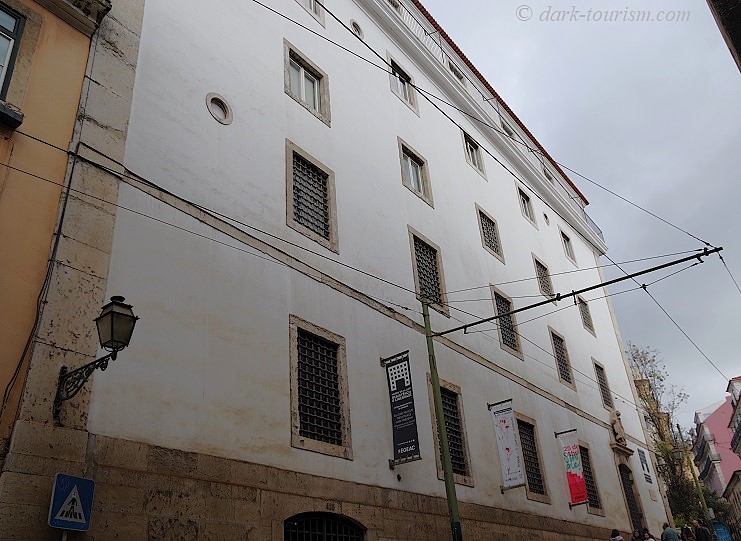
When I was last in Lisbon in 2013 this site hadn’t yet been commodified for visitors, the exhibition about the dictatorship, political repression and resistance (mainly by communists) only opened in 2015. So it had long been high on my priority list for a return visit to Lisbon. Now I finally made it there. And what’s it like? Well, not bad, though quite text-heavy and maybe a bit demanding for those not already well familiar with the history of the decades of dictatorship in Portugal. The exhibition features only a few original artefacts but at its core it has a row of reconstructed small “pens” (very narrow and dark punishment cells), one of them complete with a dummy prisoner made of white papier mâché:
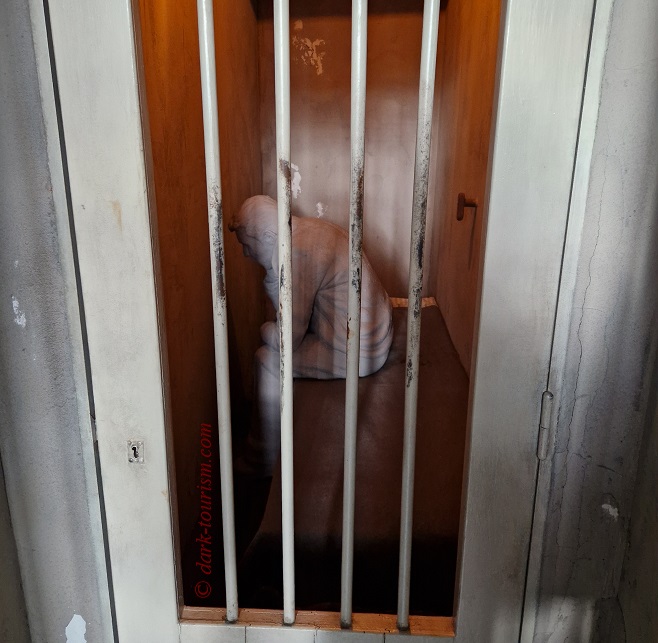
After two nights in Lisbon I then got a train up to Porto, where I had never been before … it too is quite a glorious, charming city.
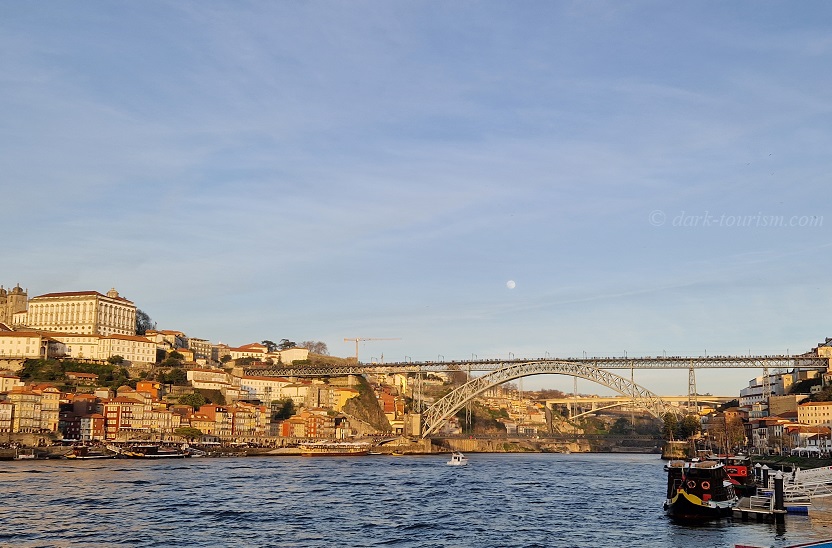
The photo above, taken during the “golden hour” of evening light, shows one of Porto’s main iconic landmarks, the “Ponte Luiz I”, one of the city’s two historic 19th century iron bridges across the Douro River (there are now also four more modern ones). This photo was taken from the southern banks of the river in the Gaia district – which is also where all the “caves” (cellars/warehouses) of all the producers of port wine are located, including all the familiar names as well as several smaller, less famous ones.
I hadn’t actually travelled to Porto primarily for dark-tourism reasons but for the city itself, of which I had heard so many good things. But sometimes the dark side finds me even when I’m not actively looking for it (an experience also shared by this DT book’s author). Admittedly Porto’s DT portfolio is on a small scale, but here’s for example a photo of the old city prison:
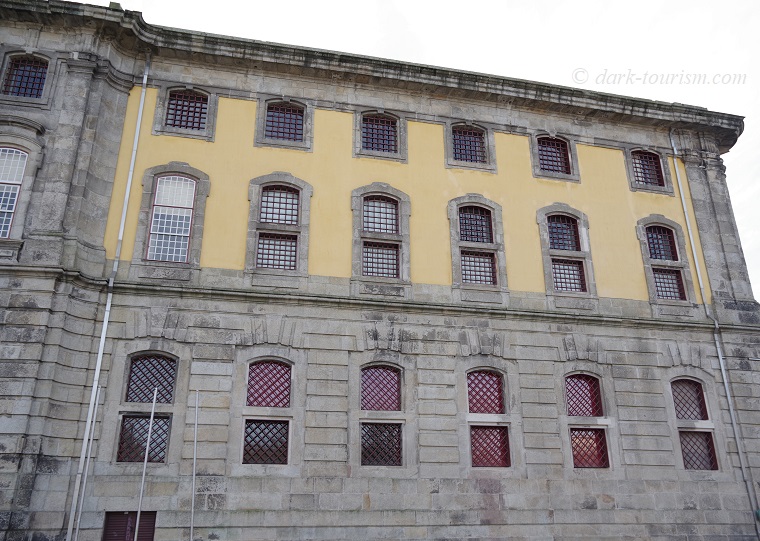
These days the building is home to the “Portuguese Centre of Photography”, which may have been interesting in its own right – but as it was a Monday the exhibition spaces were closed. I only managed a quick glimpse into the foyer, but then had to leave.
A main tourist attraction I passed was the Livraria Lello, a historic bookshop with an elaborate wooden interior – but here the Instagram curse really hit. Apparently the shop was inspiration for some of the scenes in the Harry Potter movies and has since become so popular with tourists that an entrance fee is levied and long queues form. And when I say I long queues I mean really, really crazily long. There were several hundred people standing in a line you could barely see the end of (and that in the off-season in mid January!). I don’t want to know how many hours those poor sods had to wait until they finally got inside the bookshop so they could all take the same identical Insta photos. Needless to say I decided against joining the queue.
Instead I moved on to the duo of churches of Carmo and Carmelitas, famously separated by a tiny, super-narrow “Hidden House” (marked by an added arrow in this photo so you know what to look for):
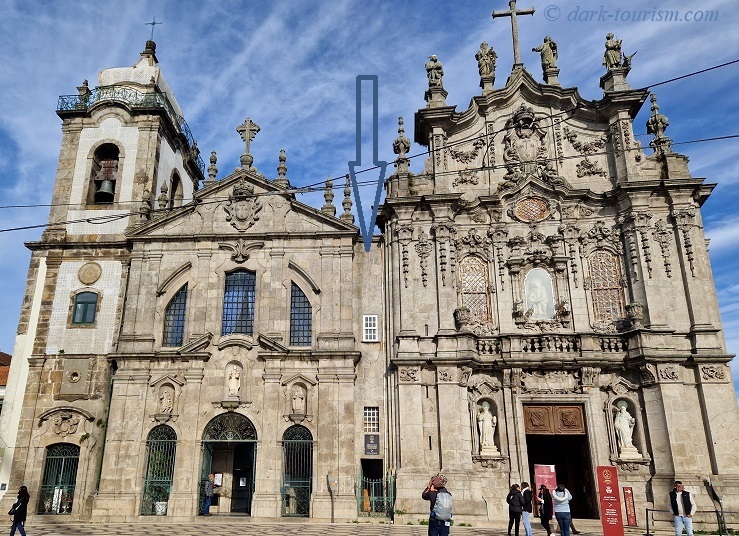
To get into the “Hidden House” you have to buy a ticket for the whole museum complex of the Carmo church. The interior of the “Hidden House” is indeed narrow, but surprisingly not quite as narrow as the barely four foot wide front facade would lead you to believe. Inside, some rooms were definitely wider. And then in the crypt of the church a dark surprise was waiting:

In addition to this skull and collection of bones under a glass plate in the floor there was also a coffin with a mummified body on display (though I’m not entirely sure whether the mummy seen here is still genuine):
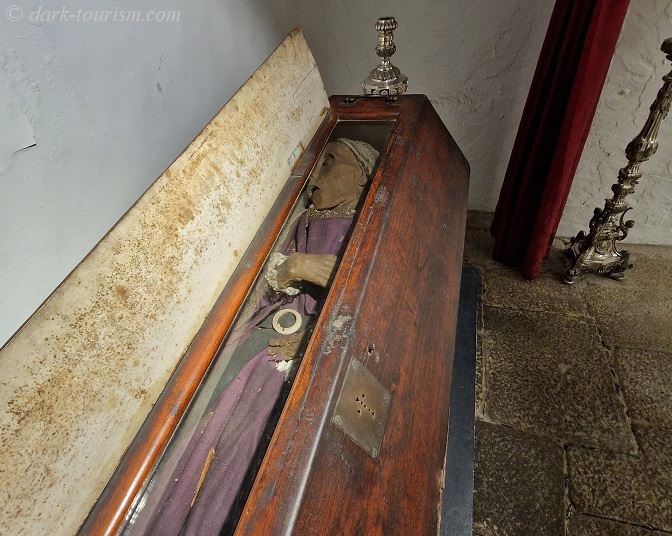
After two days in Porto I got the train back to Lisbon, where I spent half of the next day on the other side of the Tagus River. From the ferry and then from the opposite shore you get nice views of the Lisbon skyline and of the famous Golden-Gate-like “Ponte 25 de Abril” … but for me the key attraction was something altogether different: the abandoned former Lisnave shipyards. The enormous steel gantry crane over what was once one of the largest dry docks in the world provides a contemporary iconic landmark:

The entire abandoned shipyard would have been a superb playground for a spot of maritime urbexing … but unfortunately the whole vast area was fenced off, warning signs prohibited any trespassing, and there were no holes in the fence – moreover I could make out patrolling police vehicles in the distance, so it really wasn’t possible. Instead I just walked almost the entire circumference and occasionally took photos through the fence, such as this one:
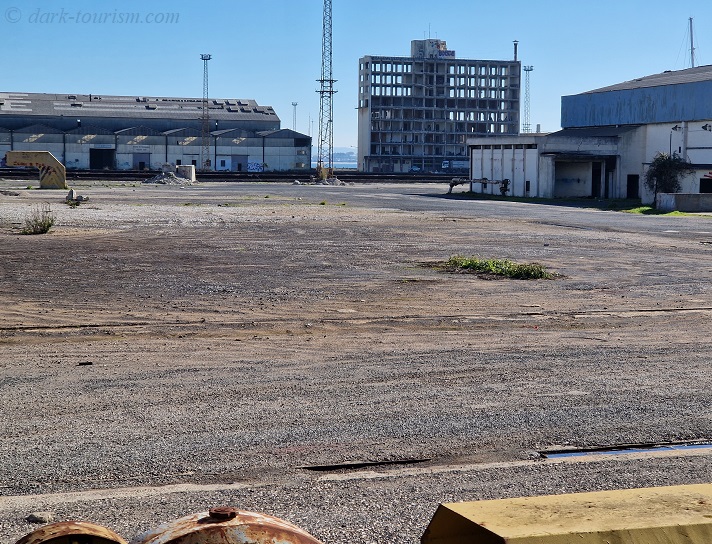
On the other hand, not far from the north-western end of the shipyard complex back en route to the river ferry there’s a submarine that’s been turned into a museum vessel … it’s the S164 Barracuda, built in France in 1964 for the Portuguese Navy and decommissioned only in 2010 (and has been open as a museum only since May 2024):

I always find submarines have something somewhat spooky about them – and I mean that beyond the military roles they play. Just the cramped conditions inside and the whole idea of travelling clandestinely below the water surface for days and weeks on end. And for someone who’s as tall as I am it’s also always a challenge in practical terms to navigate through a sub’s interior …
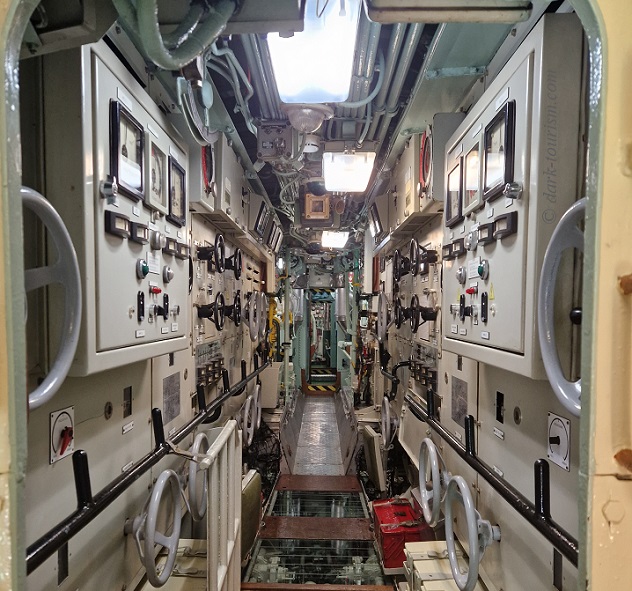
From Lisbon’s airport, I then hired a car and first headed towards the coastal town of Peniche north of Lisbon. And the reason I went there was this: Peniche Fort (same photo as the featured one at the top of this post):
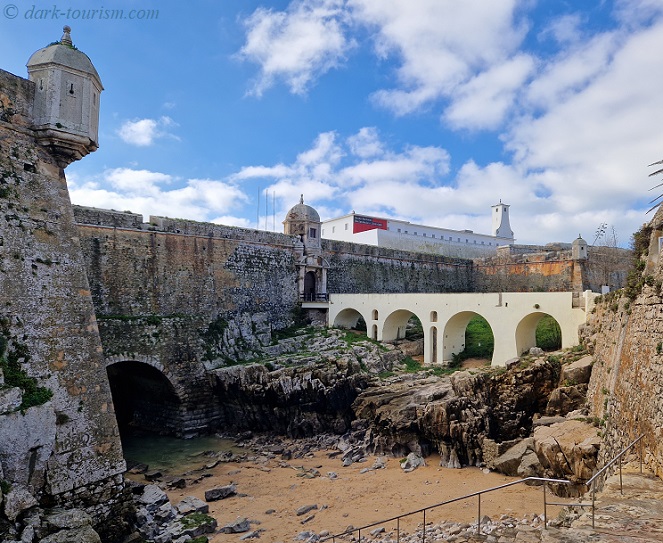
This old coastal fortress was during the Salazar dictatorship era converted into a prison, and especially during the 1950s and 60s it became the most important detention centre for political prisoners on the Portuguese mainland (there were many more, also including camps in the colonies, such as the infamous Tarrafal in Cape Verde).
Peniche Fort was commodified for visitors only recently, after years of development finally opening its doors to the general public in April 2024, just after the 50th anniversary of the 1974 “Carnation Revolution”. Its official name now is ‘National Museum of Resistance and Freedom’. I had followed its development to some degree and in anticipation of its opening already chose the site as the sole single-destination chapter for Portugal in my book Atlas of Dark Destinations, which was released in late 2021. Now that the museum had actually opened this was of course the most significant gap I had to close on this recent trip!
It’s quite a big complex and includes a museum in one part that is not dissimilar to the exhibition inside the Aljube in Lisbon (see above), except that a) it’s even more comprehensive in its coverage, and b), unlike the ones at the Aljube, the cells you can see here are not reconstructions but the real thing. So Peniche Fort wins hands down in terms of authenticity when compared to its counterpart in the capital. Here’s a photo of one of the original cell tracts:

From Peniche I embarked on the long drive down south-east deep into the remotest corners of the Alentejo region, close to the border with Spain, namely to see the Mina de São Domingos. As the name suggests this is a mining town and also the name of the adjacent former copper and pyrite mine that was abandoned in 1966. I had discovered some info about it during my pre-trip research and from the photos I’d found online I was more than keen to see this extraordinary place with my own eyes and take plenty of photos. It’s rural urbexing at its best and hence deserves more than just one or two photos in this post. Here’s a first photo of one of the crumbling mining structures (whose former functions I have not been able to work out – if anybody can enlighten me, please do!):
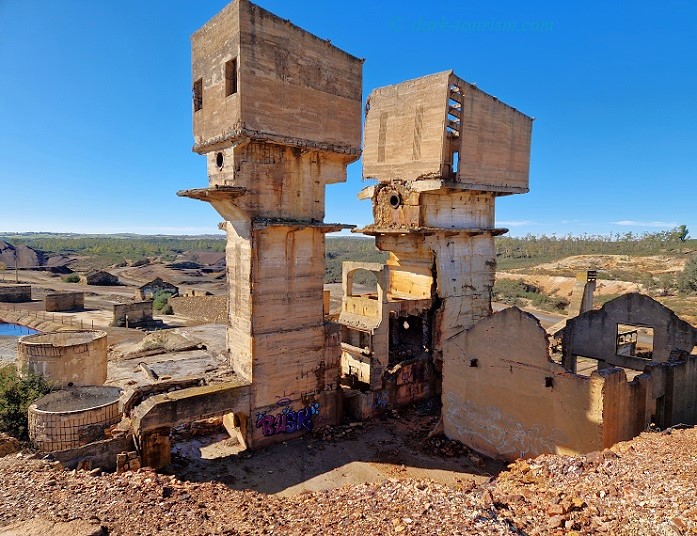
The water in the various ponds with the mine complex are a deep blood red from iron and sulphuric acid dissolved in them, so it’s a stunningly visibly toxic place as well:

And it doesn’t just look toxic – it really is, hence the many warning signs you see placed near the waters’ shores, such as this one:

Along the way into the more remote parts of the vast mining complex I also happened upon this dead fox:
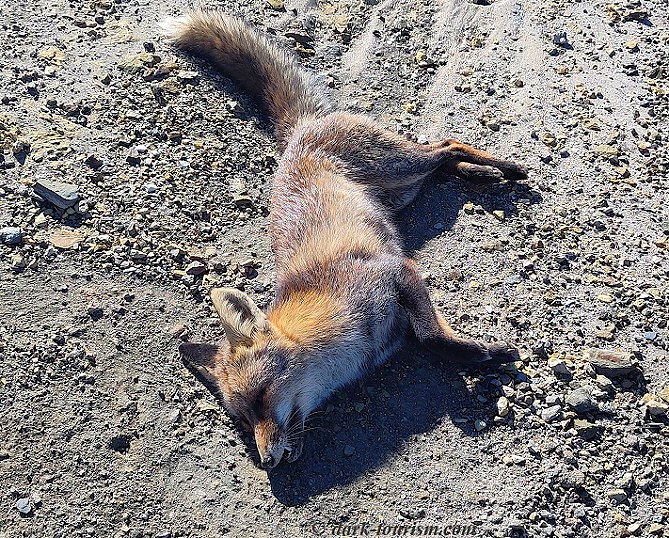
It looked like it was just having a peaceful lie-down, with its paws tidily parked and its neck and tail stretched out – and it was fully intact and looked quite healthy, really; there were no signs of any injuries, no blood, nothing. And its eyes were still open. It clearly hadn’t been lying there for long. There was only one solitary fly buzzing about the cadaver. I wondered what it could have been that led to this beautiful creature’s untimely death. I took a few photos and later that day sent them to my sister, who is a vet by profession, and asked her opinion. And her first guess was the same as mine: the fox looked like it’d been poisoned. The alternative explanation could have been that it was hunting season, so maybe some wayward hunter shot it, but the complete absence of any blood and the peaceful posture of the fox made the poisoning theory indeed much more plausible. But how that may have happened remains a mystery. I doubt it’s from the animal drinking any of that toxic red water. If this was its terrain it would have known to stay clear of those ponds.
The largest and deepest accumulation of such red toxic water was closer to the village, namely inside the former open-cast mining pit which had also filled with an acid lake. It reminded me very much of the “Blood Lake” Kokkinolimni of Mitsero in Cyprus (see also this older Blog post):
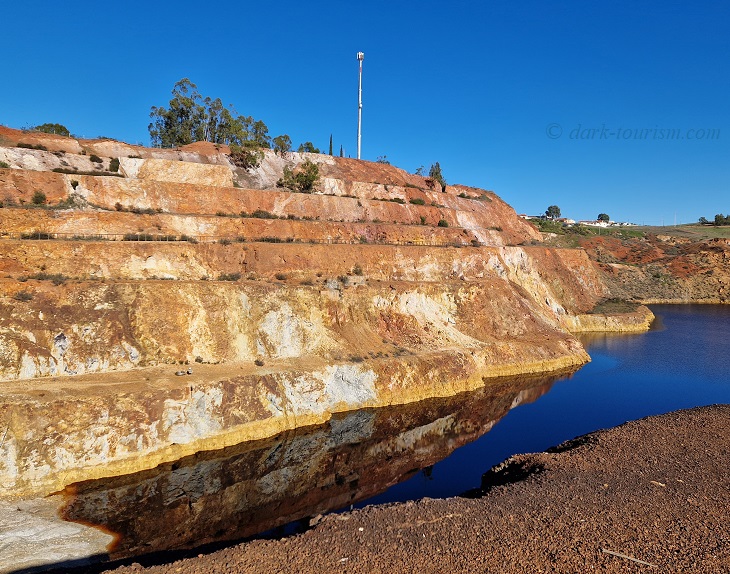
The mining operations here were owned by a British company – and indeed the place where I stayed for two nights was the former mine owners’ mansion that had been converted into a hotel (sounds more glamorous than it turned out to be – the hotel mostly hosts groups of athletes, kayakers in particular, so the dress code was far from dinner jacket and tie … stripy tracksuits and slippers more like …). Nearby was also an English Garden with a bandstand. And high above the open-cast mine is still a “cemitério dos Ingleses”, i.e. an ‘English Cemetery’:
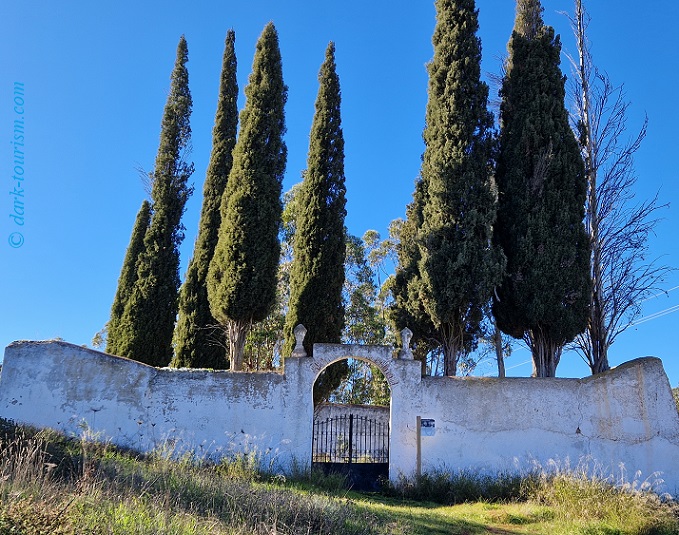
The gate was padlocked but you could peek in through the bars and make out the six tombstones still standing in this otherwise totally overgrown old burial place:
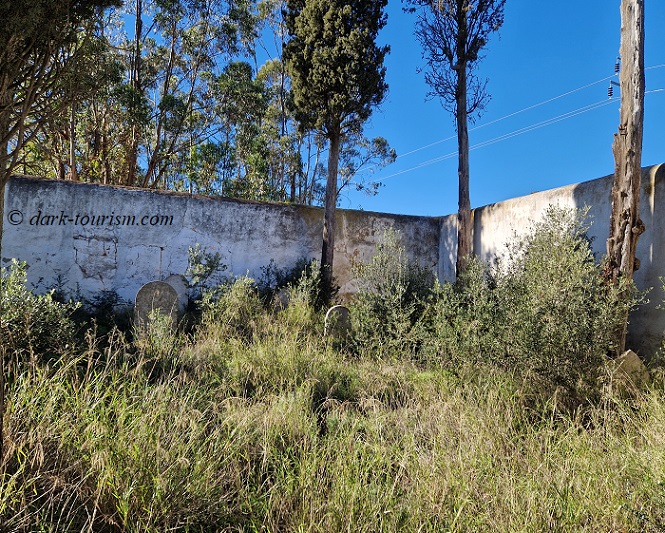
My final stopover on this trip (before returning the hire car to Lisbon and flying home) was the historic town of Évora. This was of DT importance for one of the world’s most famous bone chapels or ossuaries (aka ‘charnel houses’), namely the Capela dos Ossos of the São Francisco church complex:
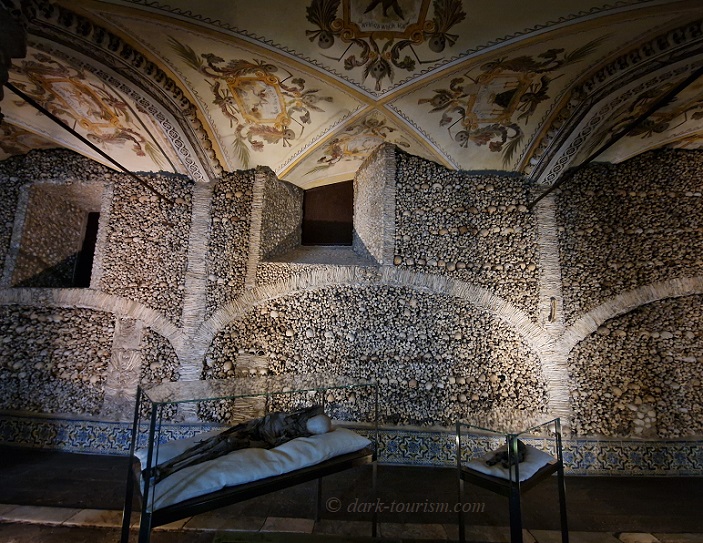
The walls are made of dense stacks of masses of human bones with numerous skulls inside them for ornamentation too. In addition there were two whole-body semi-mummies, one a mere tiny shape: a baby mummy! The details of the columns were also suitably spooky – and unlike at so many such places (e.g. Sedlec), here photography was not forbidden!

This concludes this short overview post and photo essay. The material I gathered from all these places will keep me busy for weeks, first processing all the RAW-format photos and then drafting new chapters (or expanding old stubs) for my main website. Some of it may also feature again here on the Blog, but I also still have themed posts to deliver. And then of course there’s also still quite a bit of leftover work to be done for Australia as well as from all the material I gathered earlier this month while still in the UK, especially London. In short, I won’t run out of things to do any time soon …
But for this Blog post this is it. I hope you enjoyed it.


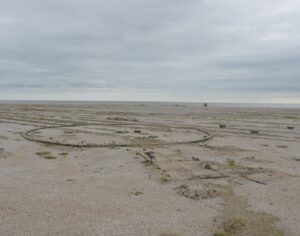
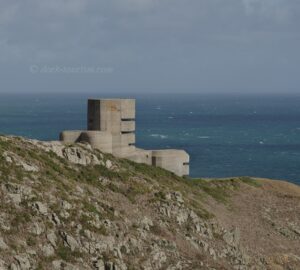
One Response
Great read! I am planning to visit Lisbon and Porto in March, so I may be able to visit some of these places.